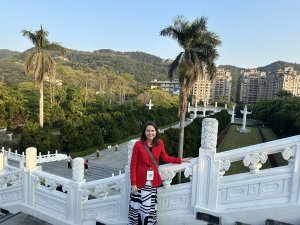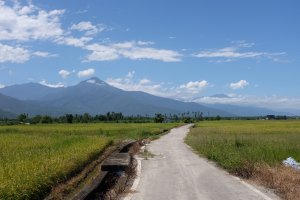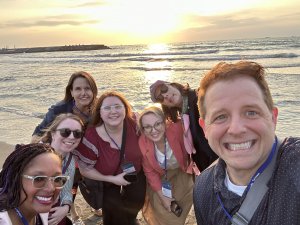When I submitted my research proposal during the Fulbright application process, I understood that the architectural sites of the Taiwanese indigenous Rukai and Tao people would be challenging to access. True enough, to reach the Tao site on Lanyu Island, I had to board a small airplane with limited seats. There was also the option to take what was described to me as a turbulent, sea sickness inducing ferry. I opted for the small airplane. But the Rukai site is a six to eight-hour hike up Beidawu Mountain (北大武山) in a mountainous region in Pingtung County, making the trip to Lanyu Island seem simple in comparison.
I am not a recreational hiker, and on Monday, April 25, I came to understand the magnitude of the journey to Kucapungane, one of Taiwan’s major Rukai settlements. Beidawu mountain is located in Southeast Taiwan and stands at an elevation of 3092 m (10,144 ft). A subgroup of the Rukai community settled in this area in the early 1600’s and through a remarkable integration of architecture within nature built housing into the cascading tiers layered in the mountain. Since Rukai members decided to relocate the settlement in 1974 to have greater access to modern amenities and economic opportunities, however, the site in Kucapungane has largely been abandoned and fallen into ruin. In terms of materials, the Rukai planned a space using mountain stone to create walls and large trees to create roofing structures. Carved out of the stone found throughout the mountain, the stone slabs are resilient, and have stood the test of time, largely remaining throughout the settlement though in a ruinous state. The wood has rotted and collapsed in most homes. As a building material, the wood materials are the most difficult to acquire and the most difficult to maintain. It takes approximately 20 years to grow the structurally appropriate tree needed for a beam. And while the mountain is covered in trees, the trunk of a typical tree lacks the diameter needed to create a beam with the necessary structural integrity. Since Rukai members decided to relocate the settlement in 1974 to have greater access to modern amenities and economic opportunities, the site in Kucapungane has largely been abandoned. In 2016, the settlement was declared a heritage site by the World Monuments Foundation, and since then, has been in a gradual process of restoration. The majority of the Rukai community currently live in Rinari Settlement at a substantially lower elevation where residents can enjoy greater accessibility by car and beautiful views of Beidawu mountain.
The natural landscape surrounding Beidawu mountain is stunning. When most of my friends and family members in America were completing their Easter Sunday celebration rituals; I was beginning my Monday by admiring nature’s creations. As we started our journey, (five students, a co-professor from National Taiwan University, a teaching assistant, and two guides), I looked up at the mountain, and I took in the fresh air. I took a vow to be present and mouthed beneath my breath, “This is crazy.” Perhaps it was louder than I imagined because I overheard one of my students giggle, and she subsequently added, “I also think this is crazy.” At the same time, I mentally acknowledged that this site is one of the primary reasons I came to Taiwan, and my passion for architecture had managed to remove me from my comfort zone. Existing indigenous architecture is rare particularly with this type of historical context. So I extended myself so that I could gain access to this unique architectural site. Staring at the beauty of the mountain and the surrounding riverbed, I confirmed that the most beautiful places in this world are natural landscapes, and architecture has yet to live up to what was created naturally. Mother Nature is brilliant. She will always be the greatest architect of all time. There are some spaces that have been designed with the express intent to mimic nature’s aesthetic wonder— The Bird’s Nest in Beijing, Fallingwater in Pennsylvania, Sagrada Família in Barcelona, and Lalibela in Ethiopia. These architectural icons are all exquisite, and yet pale in comparison to the beauty I was witnessing, and most architectural projects in towns and suburbs around the world, do not bother to make the effort to meet this standard.
Dr. Shu-mei Huang, co-professor and experienced hiker, was thorough and provided a detailed hiking prep list for our group. I purchased equipment I had never owned before from a local store, and when the retailer relayed the total price, my instinct regarding the economic privilege associated with this hobby was confirmed. My backpack was 9 kg. I made sure not to fill my water bottle completely, keeping in mind the physically demanding nature of the journey aheadThe hike was quite difficult for me. The first leg of the journey was walking along a flat but rocky riverbed; this seemed like a safe beginning. The mountain is massive and this walk began to give me a sense of the scale. I looked up into the mountain to see if I could catch a glimpse of the settlement, but it had yet to reveal itself. When we reached the end of the path to the foot of the mountain, our group took a brief rest. I looked in both directions and could see no possible way forward.
In this I was mistaken. Our guide showed us how to navigate a series of rocks with grace, though I cannot claim that it was with ease. I felt clumsy and awkward, but he helped us navigate the way safely, and I can say that I survived un-scarred. The hike varied. I am unaware of the technical terms, but during my ascent, I imagined a time when the Rukai tribe made these journeys with less manicured conditions, while carrying much heavier loads. I felt a consistent pinching in my right shoulder and was relieved anytime I could release my backpack. Being present in the environment also meant being present with the pain.
The journey is an immediate connection with nature, and I was aware that my actions had a very direct environmental impact. The systems I have grown accustomed to are convenient, but not environmental nor do they make me conscious of my consumption. When I produced waste, I had to find a way to store it; human waste, water resources, I was hyper aware. We were told we would not have access to shower but fortunately our host surprised us by giving us access to a makeshift shower when we arrived. The shower was boiling hot water heated on a stove, as well as cold water piped in from a nearby creek. There was a bowl in the shower room where you could achieve a more comfortable temperature by combining the cold and hot water.. Being conscious and aware of the systems that we take for granted is a step to beginning to understand how every action impacts the environment.
Arriving at Kucapungane after a seven-hour hike, my first priority was to get some rest. There was a shared space near the home where our group would be sleeping with a roofed area that was open on all sides and was positioned in a way that felt as if I was cantilevered over the mountain. Peaking over the edge, I could see that the structure was situated so that if I dropped something below it might be impossible to retrieve it. The common area was organized with a place to cook, dine, and casually gather. The space provides protection from the rain, yet still allow 360 degree views of Beidawu Mountain. This is where our group shared most of our meals. Taking a moment to sit on an actual surface, I observed the home directly across from me. While admiring the stone slabs, the proportions of the aperture, and the personalized objects surrounding, I glanced at the roof and noticed a small solar panel. The Kucapungane settlement has been in existence for several centuries, and I was witnessing one of the most modern environmental integrations for energy collection. This solar panel represents the conflict within the Rukai Tribe to evolve while maintaining authenticity. Efforts to preserve Kucapungane and teach younger tribe members historic building techniques are important to tribal identity; however, there seems to be a conflict between modern and traditional values. Once Rukai tribe members had access to “on-the-grid” comforts in successive relocated sites, preserving Kucapungane as it was originally conceived historically has been a challenge. Culture is not static. People are not static, yet there is an expectation of how historic architectural sites should be. This very same debate was posed after a fire overtook the Cathedral of Notre Dame in Paris; the conclusion in the restoration of Notre Dame was to choose tradition.
The most striking element of the Kucapungane settlement is the creative site planning. The way the homes are organized and settled into the mountain must have required intentional and thoughtful planning. Even the spacing between the homes is harmoniously consistent. Each home is linked by a common slate-inlaid patio and that patio acts as a sidewalk connecting each building. Imagine walking from home to home, entering each of your neighbors’ front yards. Imagine the ways that your relationships with your neighbors might be different if this was your community’s design. Some homes were built with a seating area surrounding the patio signaling that they had been spaces welcome for a pause, and others are just enclosures that had signaled you should pass quickly. The architecture itself is in various states of preservation. There are homes that have been continually maintained by families throughout the years, and there are others that have not. I could clearly see the walls, stacked with slabs of slate, have an advantage in maintaining the structural longevity of the space. They remain jutting out at various heights.
The size of homes may vary based on the hierarchy and family importance, ranging from 168 m to 250 m wide. When walking into the spaces, what I have noticed not only here but throughout East Asia is that the threshold height is usually lower than my 168 cm, and the entry is built so that the visitor must raise her foot to step inside to avoid tripping while simultaneously bowing her head. If you bump your head or stumble, you will certainly remember the next time that in order to enter this space you must always bend down and lift your foot. Here the typical door height is 163 cm or less, so one could imagine that the time these areas were built the society was much more petite, but it has also been said that when you enter into a home you must humble yourself by bowing to the ancestors, and the compressed structure makes this a physical requirement, forcing you to bow before you enter the home. Once you enter, the interior material is a dark stone, and the space has minimal windows. In fact, when we slept in one of the homes, the morning was so evident, that when the first person opened the door, light punctured the space like a shard. The space inside the house had a total of two evenly sized rooms. There were twelve people total asleep in the house, and I think we were all so exhausted from the hike that sleeping on a stone slate floor, lined up like sardines in sleeping bags, seemed comfortable. The exterior environment in the mountain is so pleasant, and I can imagine the public exterior area was occupied more than the home was throughout the day. The home serves the function for protection from extreme weather, some cooking, storage of personal items, and sleeping. We spent three days and two nights exploring the Kucapungane site but most of our time was spent outside of the actual built space.
The restoration of Kucapugane poses societal questions that are not uncommon to heritage sites. Only Rukai members 40 and over have lived in the original settlement of Kucapungane, and community members that have the most vivid memory of the settlement are aging. When the Rukai Tribe made a decision to relocate in the 1970’s, they were no longer relying on weaving techniques for clothing, but had started to purchase manufactured items. In 2009, after Typhoon Morakot, they were forced to relocate again from Huocha to Rinari settlement in Majia Township. After the World Monuments designated Kucupagane a heritage site, the Taiwan Ministry of Culture proposed to renovate forty of the over 200 homes over the next 10 years. Restored homes were decided by a lottery application process that, after being picked, requires family financial investment as well as participation in the construction process. The approach to restoration will likely be a continued negotiation between the Taiwanese government and the Rukai tribe members, but I am curious how the Rukai tribe members will continue to balance their conflict with tradition and modernity. There are no right answers.
I felt privileged to have this experience and to have access to the Rukai way of life. After my journey to Kucapugane, I was keenly aware of the sustainable systems in place at the settlement. When our hiking group reached the level walking path on our return, the group noticed some scattered trash, which initiated an impromptu waste clean up of the area.It was a small gesture, but these actions showed a genuine compassion toward nature. I am certain that our experience in Kucapugane impacted our actions in that moment, where the need to protect nature outweighed our feelings of exhaustion. The memories and details of this journey will forever be embedded in my mind and shape the perception of my Fulbright year. In April 2019 my hometown, New York, passed the Climate Mobilization Act. As an architect and interior designer in a city that is evolving environmentally, I hope that I can use my research on indigenous architecture to design sustainable strategies for the built environment.
Editor: Josh Stenberg





